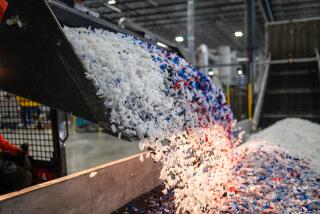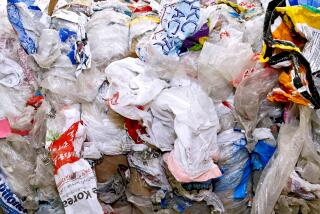Recyclers Set to Reap a Harvest of Cans, Bottles
- Share via
Down at Paul Brown’s South Bay Recycling in Chula Vista, there are some major league improvements going on. A fresh driveway is being laid and some snazzy signs are going up. A new scale has arrived and Brown is doing some general tidying up--”just to make the old place look more attractive.”
The motivator here isn’t a sudden spurt of civic pride. Come Thursday, the state’s new recycling law takes effect, instantly making aluminum, glass and plastic beverage containers worth a penny apiece.
And, like fellow members of San Diego County’s recycling brethren, Brown is hoping you’ll think of him when trying to decide where to hawk your soda cans and beer bottles. He figures a little sprucing up of his Center Street business might give him an edge.
“We’re a mom and pop operation--a little bit off the beaten track--so we’re doing what we can to compete,” said Brown, 64, who figures he has been into recycling “about as long as the aluminum can” has been around. “Nobody really knows what effect this law is going to have, so we’re all a little nervous . . . and excited.”
Ready Throughout County
From Escondido to San Ysidro, Pacific Beach to Santee, those two sentiments seem to be dominant here as the state’s ambitious new recycling program swings into gear this week.
Although they’re hopeful the law will help them reap a harvest of cans and bottles from consumers suddenly bit by the recycling bug, Brown and other veterans in the business just aren’t sure how the thing will shake out.
Passage of the law last fall capped a two-decade battle between environmentalists and the powerful beverage industry over how to encourage recycling of containers that historically have been discarded--frequently as litter along the state’s highways and beaches.
Recycling advocates for years pushed for an Oregon-style “bottle bill” under which consumers would pay a nickel extra per container and recoup that money upon returning the container to the store. But beverage manufacturers bitterly resisted such a measure, arguing that the system would be too costly and cumbersome.
Under the compromise law--unique in the nation--supermarkets that do more than $2 million in annual sales must establish a state-certified recycling center to accept aluminum, glass and plastic beverage containers within half a mile of their premises--a radius dubbed a “convenience zone.” There are 2,700 convenience zones in the state, 176 in San Diego County.
Grocers Have an Option
The grocers have the option of running their own facility or contracting with a private company for the service. Consumers receive a penny for each plastic, glass and aluminum container--all of which will soon bear the label “CA Redemption Value”--they bring in.
Unlike traditional bottle bills, the California law requires beverage distributors to pay a penny for each of the 10 billion containers produced in the state each year. That fee--which is expected to be passed on to the consumer--goes into a state fund, which is used to reimburse recycling centers for payments they make to people returning their empties.
While the date for establishment of the centers is Thursday, a grace period gives grocers until Jan. 1 to bring their programs on line. After that, the supermarkets and all other beverage vendors within the surrounding convenience zone must either accept the containers themselves or face fines of $100 a day.
Interviews with the major supermarket chains indicate that few stores in San Diego County will be equipped to accept containers as of Thursday. Steven Koff, president of the Southern California Grocers Assn., estimated that about 20% of supermarkets statewide will have programs up and running by the end of the week.
While most grocers have signed contracts with private recycling firms to provide the service, the logistical task of securing permits and state certification as well as deploying equipment at each store site has proven overwhelming, supermarket officials say.
City Permits Necessary
In addition to obtaining landlord approval for the recycling facilities, the supermarkets must seek local government’s blessing, which can be a lengthy process involving a change in zoning regulations.
“Each city has different regulations that they want you to meet and each city wants you to appear before the council and tell them what you’re doing. All that takes time,” said Ron Schweitzer, general manager of Orange County-based Mobile Recycling Corp., which has a contract to provide services for Alpha Beta’s 250 California stores. “One city wanted us to build a concrete wall around the operation. Another asked us to put up a trellis with plants.”
Such problems are compounded by the fact that less than a year ago, companies such as Mobile Recycling didn’t even exist.
“Since May, we have created a company, invested $12 million, hired 1,200 people and begun to set up recycling centers at 1,100 sites statewide,” said Susan Thurman, a spokeswoman for Irvine-based 20/20 Recycle Centers, which has contracts with five supermarket chains. “A whole new industry has been born in less than a year.”
A spokeswoman for the state Division of Recycling said that as of Friday, 84 centers in San Diego County had been certified for operation. But Bonnie Lewis, public relations manager for Safeway, said it is doubtful that chain’s 42 local stores will have recycling centers in place by Oct. 1. A spokeswoman for Von’s gave a similar prediction, noting that the company’s 29 San Diego County stores will not be equipped before mid-November.
Alpha Beta Moves Ahead
Alpha Beta appears the furthest along in the game. A spokesman estimated that recycling centers at the first of its 25 local stores will be up and running by mid-October.
Big Bear President Larry Mabee did not return telephone calls from The Times.
Under the law, the supermarkets may either set up a staffed recycling center with bins for the containers and a person to give you your refund or simply install a so-called reverse vending machine, which eats up cans, bottles and plastic jugs and spits out a penny.
While many companies favor the automated approach because it takes up less space and uses limited manpower, others complain the technology leaves something to be desired.
“Frankly, I’ve yet to use a machine I’m happy with,” said Schweitzer. “They’re slow, kind of like putting your card into an automated teller machine, asking for $80 and waiting while it pays you, penny by penny.”
But the alternative--keeping a person on the payroll in the parking lot for the state-mandated 30 hours a week--is expensive, so many supermarket officials speculate that the technological option ultimately will be the method of choice.
Even if your local supermarket has not set up its own center by Oct. 1, the state has a hot line (1-800-327-9886) consumers can call beginning Thursday to pinpoint the recycling program nearest them. Also, store managers are required to post a sign telling you where you can take your empties until their programs are under way.
Brown and operators of other existing buy-back facilities predict that could be a boon to their businesses.
Boys Club Is Ready
“Come on down!” Mike Lewis said recently, his voice barely audible above the din of the bustling recycling center at the Clairemont Boy’s Club. “That’s the message we’re trying to get out. There’s no way the supermarkets are going to be ready for this, so in the meantime, we’re hoping to cash in.”
Jerry Reyes, manager of Skyline Recycling in downtown Escondido, was just as eager: “We’re ready for the rush,” he said, noting that Skyline has worked out a referral system with a neighboring supermarket. “We’re all reading up on the law so we can explain it to people who come in. We expect a lot more business.”
Along with that anticipation, however, comes a tad of apprehension. The main concern is that the sudden wealth of centers will spread the volume of recyclable material so thin that existing recyclers may have a tough time making ends meet.
“People are holding their breath until they see what happens,” said Bob Davis, president of IMS Recycling, one of San Diego’s largest and oldest centers. “The problem is dilution of the material stream. Stuff that used to flow through 600 to 800 recycling centers in the state now will be going through 3,500 centers. So it makes it real iffy as to whether the little guys will survive.”
Davis noted, however, that established centers may have a leg up on the newcomers because many of them will provide the penny-per-container refund plus the scrap value price they have traditionally paid out.
The key to the program’s success, most experts say, is whether the volume of material being recycled increases.
Penny Not Enough?
Some recycling advocates are doubtful that a penny per container will provide sufficient economic incentive to drum up public participation in the program. But backers of the law say that economics aren’t the only reason people recycle. Many consumers save cans and bottles because they like to help the Boy Scouts, or the Girls Club. Or because diverting the containers from the trash bin makes them feel they’re doing their part for ecology.
“Time will tell us whether a penny is sufficient motivation,” said Bill Shireman, executive director of Californians Against Waste, a nonprofit group that pushed for the new law. “But I believe that people are concerned about the environment and really just need an excuse to recycle. That plus a little reminder now and then.”
That’s where an aggressive public education campaign by the state comes in.
“We’ve got our commercials and public service announcements out, and beginning Oct. 1, the public will be getting a big dose of recycling messages,” said Janie Cordray, public information officer for the state’s division of recycling.
Billboards with the recycling logo--a spiraling arrow with the word recycle--and the slogan, “Turn Up the Volume, California,” will begin popping up around the state, and four versions of the snappy new recycling jingle--country western, hard rock, middle-of-the-road and Spanish language--will debut on the airwaves in the next few days.
There will be promotional events with a recycling theme, plus a speakers’ bureau with people ready to spread the gospel. Eventually, the state hopes to develop a program to insert the recycling message in school curricula.
If all that fails to win converts to the recycling cause, however, and the state’s targets are not met, the penny redemption rate for each container will increase. The law provides that if 65% of all containers are not being recycled by Dec. 31, 1989, the refund will increase to two cents; if it’s short of the 65% mark at the end of 1992, the redemption rate will jump to three cents.
More to Read
Inside the business of entertainment
The Wide Shot brings you news, analysis and insights on everything from streaming wars to production — and what it all means for the future.
You may occasionally receive promotional content from the Los Angeles Times.










